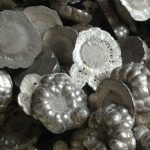Notice: Undefined index: sith_hide_share in /www/sites/alloy.wiki/index/wp-content/themes/likegoogle/single.php on line 32
Deprecated: get_settings is deprecated since version 2.1.0! Use get_option() instead. in /www/sites/alloy.wiki/index/wp-includes/functions.php on line 4862
Nitrogen in titanium alloys mainly exists in the form of nitrides, such as TiN, VN, FeN, etc., and only a small part of nitrogen exists in the form of atoms. Too high nitrogen content in titanium alloys will lead to loose macrostructures and even the formation of bubbles. The toughness decreases, the hardness increases, and the notch sensitivity increases, which greatly hinders the application of titanium and titanium alloys. Therefore, in the production of titanium and titanium alloys, it is necessary to accurately analyze the nitrogen content in sponge titanium, titanium and titanium alloys, and strictly control the content to ensure product quality.

Because the nitrides in titanium and titanium alloys have a high melting point (for example, the melting point of titanium nitride is 2950°C), it is difficult to directly determine its content by pulse inert gas melting. Researchers through the selection and combination of different graphite crucibles, fluxes, sample size, and heating power, realized the pulse inert gas fusion-thermal conductivity method of the LECO TC600 oxygen and nitrogen combined analyzer for sponge titanium, titanium and titanium alloys. Determination of nitrogen content.
The principle of the experiment is as follows: Put the sample into a graphite crucible with flux, protect it with inert gas (helium), and release oxygen and nitrogen at a sufficient temperature. Oxygen combines with carbon to form CO, and nitrogen is released as N2. The gas released by the sample is carried by inert gas through the heated rare earth copper oxide to convert CO into CO2, H2 into H2O, CO2 is absorbed by alkali asbestos, and H2O is absorbed by anhydrous magnesium perchlorate. Then, the nitrogen enters the thermal conductivity measuring cell in the form of N2, and the output of the Huisitong bridge is integrated and compared with the reference material to make a response, which is displayed as the percentage of nitrogen.
The test results are as follows: using a graphite high temperature crucible preloaded with 0.050g high-purity graphite powder and a high-purity nickel basket as a flux, the experiment shows that the best measurement conditions for the combined analyzer are: degassing power 5600W, analytical power 5000W, and degassing time 20s, cooling time 15s, flushing time 15s, integration time 65s. Through the determination of standard samples and data comparison with other units, as well as production testing and use, it is proved that the method is easy to operate, fast in analysis, and data accuracy and precision meet the needs of scientific research and production.
Guest contributors are welcome at the Alloy Wiki.It is a weekly wiki and guide on alloy information and processing technology, while also about the vast array of opportunities that are present in manufacturing. Our team of writers consists of a Machining Material Supplier / Machinist / Tool and Die Maker, a Biomedical Engineer / Product Development Engineer, a Job Development Coordinator / Adjunct Professor, and a President and CEO of a manufacturing facility.
Link to this article:Determination of nitrogen content in sponge titanium, titanium and titanium alloys
Reprint Statement: If there are no special instructions, all articles on this site are original. Please indicate the source for reprinting:Alloy Wiki,thanks!^^


